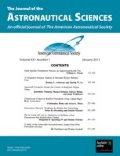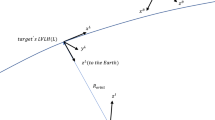Abstract
We study the reorientations of flexible spacecraft using momentum exchange devices. A new concise form of the equations of motion for a spacecraft with gimbaled momentum wheels and flexible appendages is presented. The derivation results in a set of vector nonlinear first order differential equations with gimbal torques and spin axis torques as the control inputs. Feedback control laws which result in smooth reorientations are sought with the goal of minimizing structural excitations. We pay special attention to a class of maneuvers wherein the magnitude of the momentum in the wheel cluster is held constant, resulting in a so-called “stationary platform maneuver. “ The advantage of this maneuver is that the platform angular velocity remains small throughout, thereby reducing the excitation of the appendages.
Similar content being viewed by others
References
HALL, C. D. “High-Speed Flywheels for Integrated Energy Storage and Attitude Control, “ in Proceedings of the 1997 American Control Conference, 1997.
HUGHES, P.C. Spacecraft Attitude Dynamics, Wiley & Sons, New York, 1986.
HALL, C. D. “Momentum Transfer in Two-Rotor Gyrostats, “ Journal of Guidance, Control, and Dynamics, Vol. 19, No. 5, 1996, pp. 1157–1161.
SCHULTZ, G.W. “Sub-Optimal Control of Rigid Spacecraft Reorientation Using Three Momentum Wheels, “ Master’s thesis, Department of Aeronautics and Astronautics, Air Force Institute of Technology, Wright-Patterson AFB, Ohio, December 1995.
HALL, C. D. “Momentum Transfer Dynamics of a Gyrostat with a Discrete Damper, “ Journal of Guidance, Control, and Dynamics, Vol. 20, No. 6, 1997, pp. 1072–1075.
HALL, C. D. “Stationary-Platform Maneuvers of Gyrostat Satellites, “ in KIRK, C. and INMAN, D., editors, Dynamics and Control of Structures in Space III, pp. 337–348, Computational Mechanics Publications, Southampton, 1996.
MARGULIES, G. and AUBRUN, J. N. “Geometric Theory of Single-Gimbal Control Moment Gyro Systems, “ The Journal of the Astronautical Sciences, Vol. 26, No. 2, 1978, pp. 159–191.
OH, H. S. and VADALI, S. R. “Feedback Control and Steering Laws for Spacecraft Using Single Gimbal Control Moment Gyros, “ The Journal of the Astronautical Sciences, Vol. 39, No. 2, 1994, pp. 183–203.
JUNKINS, J. L. and KIM, Y. Introduction to Dynamics and Control of Flexible Structures, AIAA, Washington, D.C., 1993.
MEIROVITCH, L. and STEMPLE, T. “Hybrid Equations of Motion for Flexible Multibody Systems Using Quasicoordinates, “ Journal of Guidance, Control, and Dynamics, Vol. 18, No. 4, 1995, pp. 678–688.
FORD, K. A. Reorientations of Flexible Spacecraft Using Momentum Exchange Devices, Ph.D. thesis, Department of Aeronautics and Astronautics, Air Force Institute of Technology, Wright-Patterson AFB, Ohio 1997.
FORD, K. A. and HALL, C. D. “Singular Direction Avoidance Steering for Control Moment Gyros, “ to appear in Journal of Guidance, Control, and Dynamics.
Author information
Authors and Affiliations
Rights and permissions
About this article
Cite this article
Ford, K.A., Hall, C.D. Flexible Spacecraft Reorientations Using Gimbaled Momentum Wheels. J of Astronaut Sci 49, 421–441 (2001). https://doi.org/10.1007/BF03546231
Published:
Issue Date:
DOI: https://doi.org/10.1007/BF03546231




